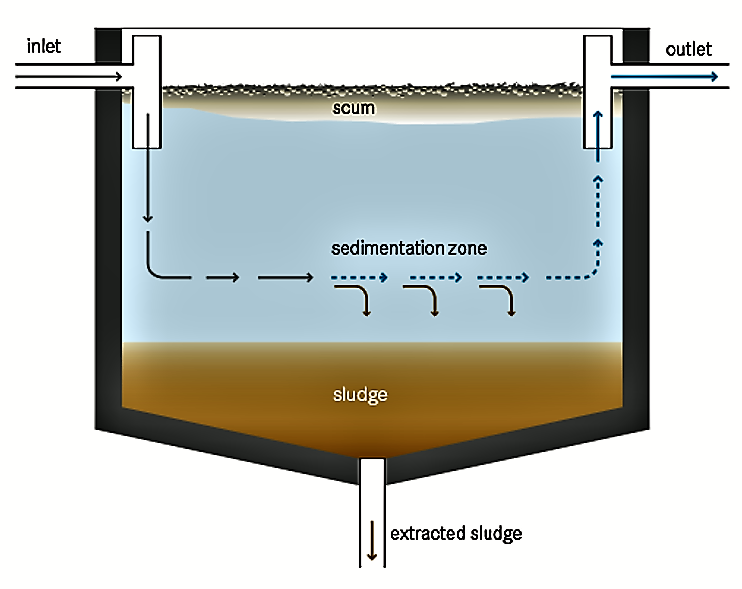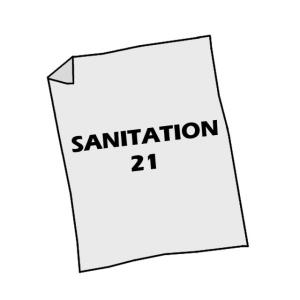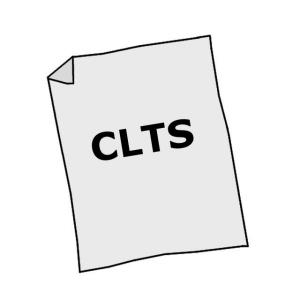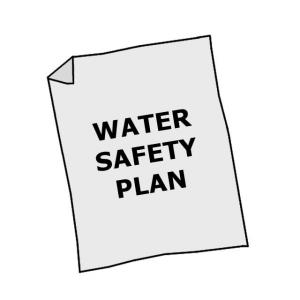A settler is a primary treatment technology for wastewater; it is designed to remove suspended solids by sedimentation. It may also be referred to as a sedimentation or settling basin/tank, or clarifier. The low flow velocity in a settler allows settleable particles to sink to the bottom, while constituents lighter than water float to the surface.
| In | Out |
|---|---|
Blackwater, Faecal Sludge, Greywater, Brownwater, Faeces, Excreta, Organic Solid Waste |
Fertigation Water, Biogas, Compost/Biosolids |
Sedimentation is also used for the removal of grit (see pretreatement technologies), for secondary clarification in activated sludge treatment (see activated sludge), after chemical coagulation/precipitation, or for sludge thickening. This technology information sheet discusses the use of settlers as primary clarifiers, which are typically installed after a pretreatement technology
Settlers can achieve a significant initial reduction in suspended solids (50-70% removal) and organic material (20-40% BOD removal) and ensure that these constituents do not impair subsequent treatment processes.

Settlers may take a variety of forms, sometimes fulfilling additional functions. They can be independent tanks or integrated into combined treatment units. Several other technologies in this Compendium have a primary sedimentation function or include a compartment for primary settling:
- the septic tank, where the low sludge removal frequency leads to anaerobic degradation of the sludge.
- the anaerobic baffled reactor and the anaerobic filter both usually include a settler as the first compartment. However, the settler may also be built separately, e.g., in municipal treatment plants or in the case of prefabricated, modular units.
- the biogas reactor, which can be considered as a settler designed for anaerobic digestion and biogas production.
- the Imhoff tank and the upflow anaerobic sludge blanket reactor, designed for the digestion of the settled sludge, prevent gases or sludge particles in the lower section from entering/returning to the upper section.
- the waste stabilisation ponds, of which the first anaerobic pond is for settling
- the sedimentation/thickening ponds, which are designed for the solid-liquid separation of faecal sludge
- the solids-free sewer, which includes interceptor tanks at the building level.
The main purpose of a settler is to facilitate sedimentation by reducing the velocity and turbulence of the wastewater stream. Settlers are circular or rectangular tanks that are typically designed for a hydraulic retention time of 1.5-2.5 h. Less time is needed if the BOD level should not be too low for the following biological step. The tank should be designed to ensure satisfactory performance at peak flow. In order to prevent eddy currents and short-circuiting, as well as to retain scum inside the basin, a good inlet and outlet construction with an efficient distribution and collection system (baffles, weirs or T-shaped pipes) is important.
Depending on the design, desludging can be done using a hand pump, airlift, vacuum pump, or by gravity using a bottom outlet. Large primary clarifiers are often equipped with mechanical collectors that continually scrape the settled solids towards a sludge hopper in the base of the tank, from where it is pumped to sludge treatment facilities. A sufficiently sloped tank bottom facilitates sludge removal. Scum removal can also be done either manually or by a collection mechanism.
The efficiency of the primary settler depends on factors like wastewater characteristics, retention time and sludge withdrawal rate. It may be reduced by wind-induced circulation, thermal convection and density currents due to temperature differentials, and, in hot climates, thermal stratification. These phenomena can lead to short-circuiting.
Several possibilities exist to enhance the performance of Settlers. Examples include the installation of inclined plates (lamellae) and tubes, which increases the settling area, or the use of chemical coagulants.
To prevent the release of odorous gases, frequent sludge removal is necessary. Sludge and scum must be handled with care as they contain high levels of pathogenic organisms; they require further treatment and adequate disposal. Appropriate protective clothing is necessary for workers who may come in contact with the effluent, scum or sludge.
In settlers that are not designed for anaerobic processes, regular sludge removal is necessary to prevent septic conditions and the build-up and release of gas which can hamper the sedimentation process by re-suspending part of the settled solids. Sludge transported to the surface by gas bubbles is difficult to remove and may pass to the next treatment stage.
Frequent scum removal and adequate treatment/disposal, either with the sludge or separately, is also important.
The choice of a technology to settle the solids is governed by the size and type of the installation, the wastewater strength, the management capacities and the desirability of an anaerobic process, with or without biogas production.
Technologies that already include some type of primary sedimentation (listed above) do not need a separate settler. Many treatment technologies, however, require preliminary removal of solids in order to function properly. Although the installation of a primary sedimentation tank is often omitted in small activated sludge plants, it is of particular importance for technologies that use a filter material. Settlers can also be installed as stormwater retention tanks to remove a portion of the organic solids that otherwise would be directly discharged into the environment.
Wastewater Treatment Manuals – Primary, Secondary and Tertiary Treatment
This manual on Primary, Secondary and Tertiary Treatment sets out the general principles and practices which should be followed by those involved in the treatment of urban waste water. It provides criteria and procedures for the proper management, maintenance, supervision, operation and use of the processes and equipment required for the secondary treatment of wastewater
EPA (1997): Wastewater Treatment Manuals – Primary, Secondary and Tertiary Treatment. Wexford: Environmental Protection Agency (EPA) URL [Accessed: 28.08.2014]











